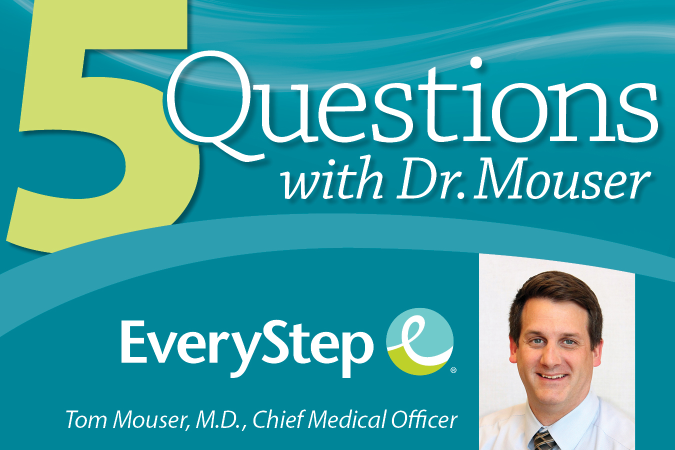August 15, 2023
5 Myths About Hospice Care

Dr. Thomas Mouser, MD, is chief medical officer with EveryStep. He is dually board certified in internal medicine and palliative care, having completed his residency at University of Iowa – Des Moines and a fellowship at Stanford University. Dr. Mouser has spent countless hours at the bedside of those with serious illness and chronic disease. In his role, he helps hospice and home care patients and their families navigate complex medical decisions as guided by the patient’s goals of care. Dr. Mouser’s fellowship training provided for an expertise in advanced symptom management and communication when working with those with high burdens of suffering. He is passionate about helping his patients reach their best quality of life so they can live life to the fullest.
In his 11 years at EveryStep, Dr. Mouser has compiled a list of the top misunderstandings about hospice care. These are his top 5.
1. MYTH: When you elect hospice care, you will have a shorter life expectancy.
Dr Mouser: I think that’s probably the biggest myth — that you really need to wait until you're pretty close to the end of life, so you don't miss out on time to live. That is not only incorrect, but it been shown over and over that a side effect of hospice care is often longer time to live. When we focus on disease and symptom management for better quality of life, rather than curative treatment that’s not working, we see people living better and longer.
2. MYTH: When you receive hospice care, we stop all your medications, put you on morphine and let you coast, unaware of reality.
Dr. Mouser: Hospice is replacement of curative care with aggressive evidence-based management of the disease in a way that makes sense for quality of life and comfort. So, we still use the medications that you've been on. For instance, if you have heart failure and lung cancer, you're going to live better if we keep your heart failure managed while we treat the symptoms from the lung cancer. If you're a diabetic, we certainly want to continue to manage your blood sugars, taking into account that your blood sugars are going to behave differently because of your illness. We continue to aggressively manage your health conditions to best provide for a better quality of life.
3. MYTH: The hospice team replaces the medical team you trust and know.
Dr. Mouser: The reality is that hospice brings in an entire team to help support that primary team that you've identified to be the lead. You as the hospice patient pick the doctor that you would like to be managing your overall health. That doctor then has the ability to ask for help and support from the hospice doctor or other members of the hospice team. Hospice is not the replacement of anything. It is the enhancement of what was there.
Learn More About EveryStep Hospice
4. MYTH: Hospice is a place.
Dr. Mouser: I’ve heard patients say, “I'm not ready to go to the hospice house yet. I want to live in my home.” The reality is most everyone receives all hospice care in their home, which helps them stay at home — wherever that patient calls home or wherever that patient is living. If it's an assisted living unit, or a nursing home in a dementia unit or wherever they are living, hospice can come in and provide services. If necessary or desired, a patient can elect to go to a hospice facility like EveryStep Hospice’s Kavanagh House, but most care is provided in the place they call home.
5. MYTH: Hospice care is only for the patient.
Dr. Mouser: Hospice care provides an important benefit for family members and other caregivers who need time to regroup and reenergize. Respite care is one of the things Medicare included when the hospice benefit was developed in 1983. It is the opportunity to receive episodic stints of five days of respite care for family members for any reason. The benefit allows for five days in a nursing facility or if there's availability, in a hospice house, and Medicare will pay for that five-day room and board. That’s a huge thing that families often underutilize in hospice when they just need a little bit of a reprieve or a break for any reason.
EveryStep Hospice is Iowa's oldest and largest non-profit, community-based hospice provider. Since launching our hospice program in 1978, thousands of Iowans have turned to us to find comfort and care when they needed it most. You can find EveryStep Hospice programs based in Centerville, Council Bluffs, Des Moines, Mount Ayr, Mount Pleasant, Osceola and Winterset. When a patient needs around-the-clock hospice care, EveryStep Hospice’s Kavanagh House in Des Moines is available. Kavanagh House provides a home-like atmosphere with private bedrooms, living rooms, a family kitchen, spa room, children's play areas and other family amenities. To learn more about EveryStep Hospice, visit https://www.everystep.org/services/hospice.
If you or someone you know is struggling to find the support they need, please contact EveryStep at 515-558-9946. Or complete the commitment-free, confidential “Find Care” form on EveryStep’s website at https://www.everystep.org/find-care. EveryStep staff will follow up with a phone call to answer your questions and provide assistance.